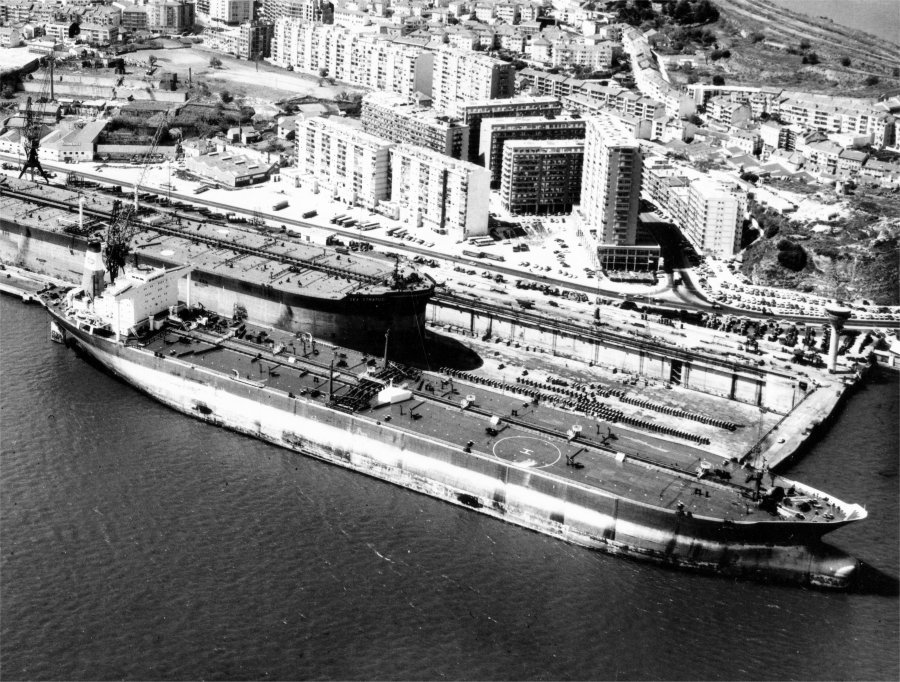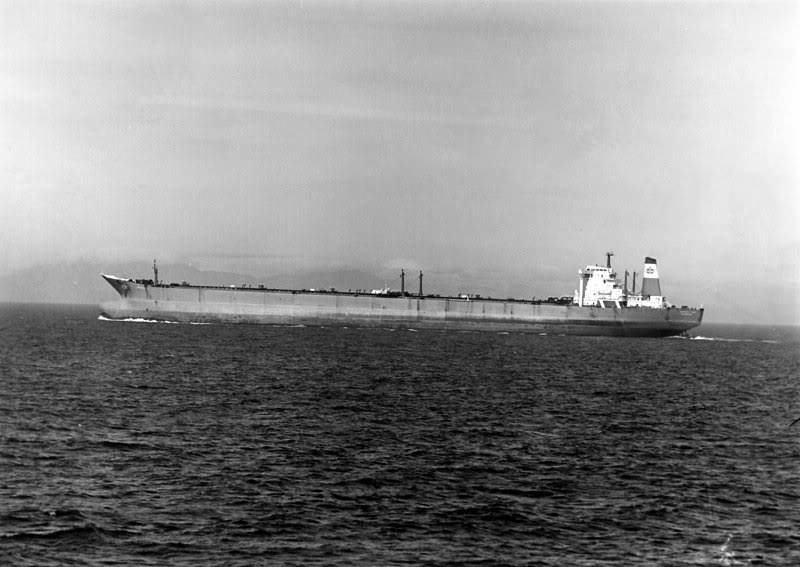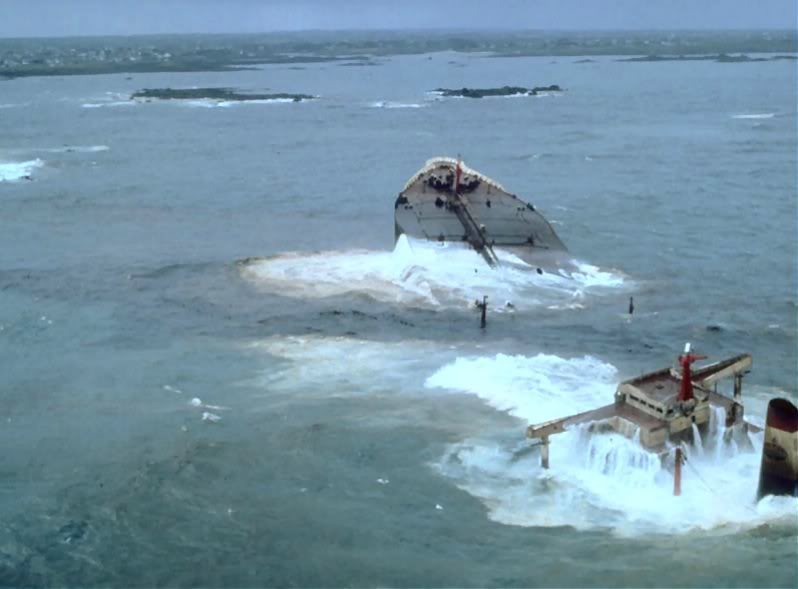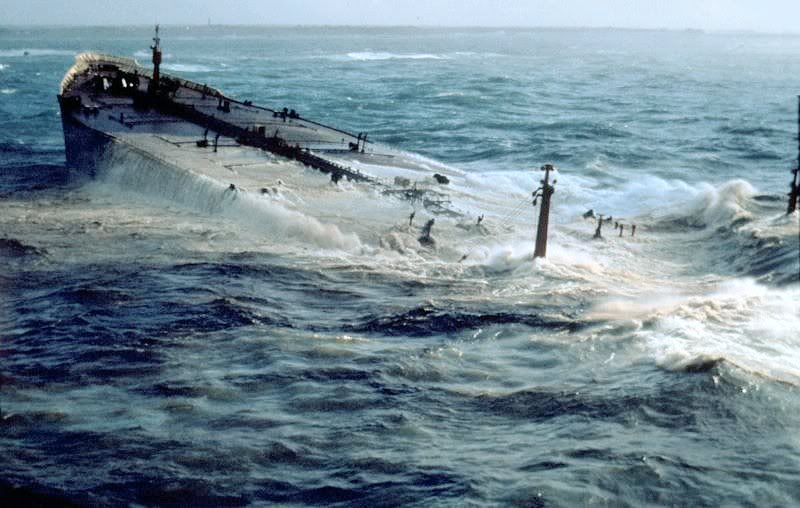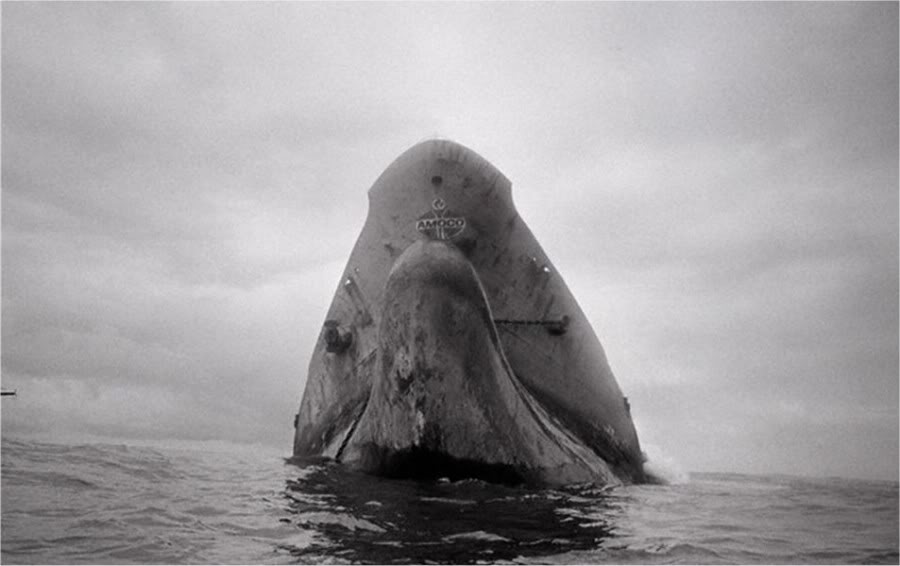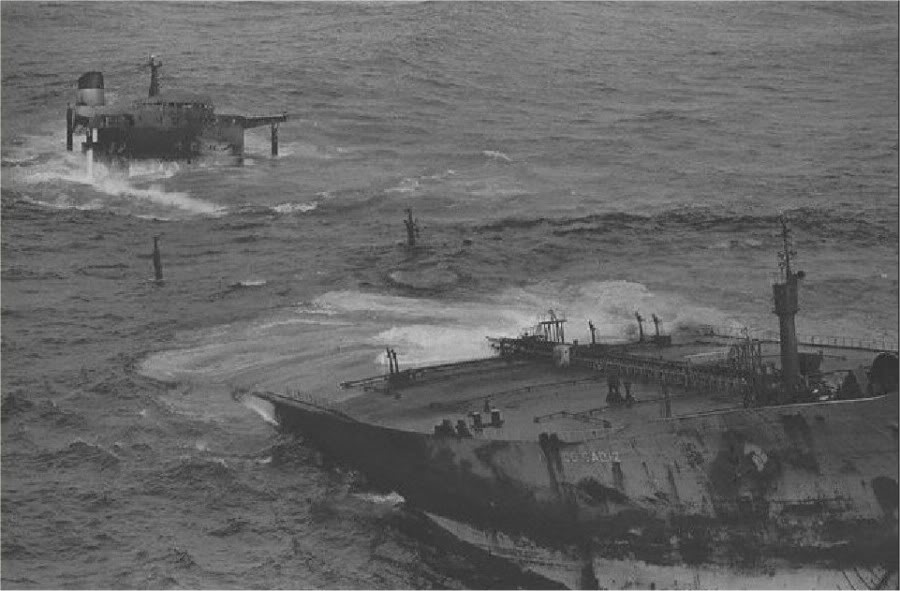Auke Visser's Int. Super Tankers - VLCC's | home
Amoco Cadiz
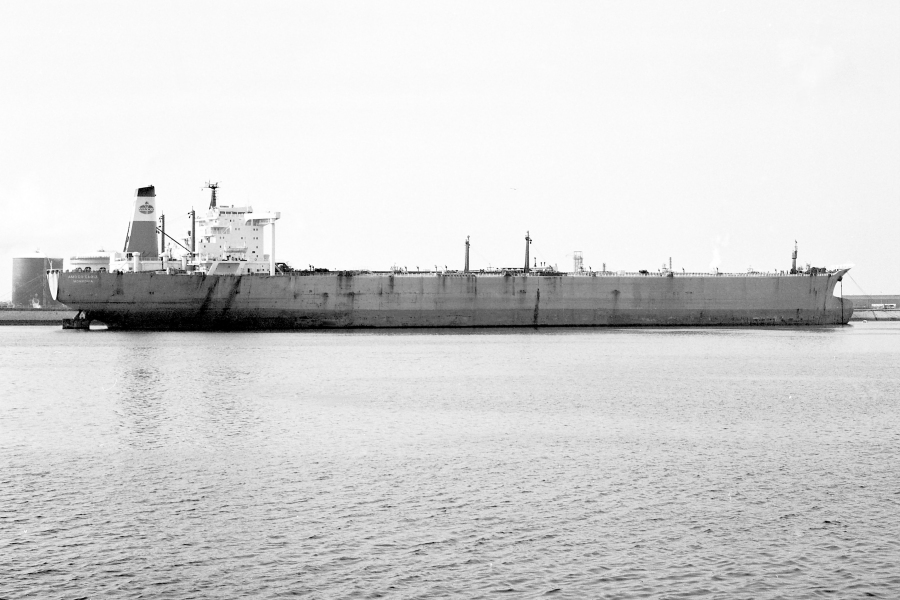
( Photo Copyright Chris Howell )
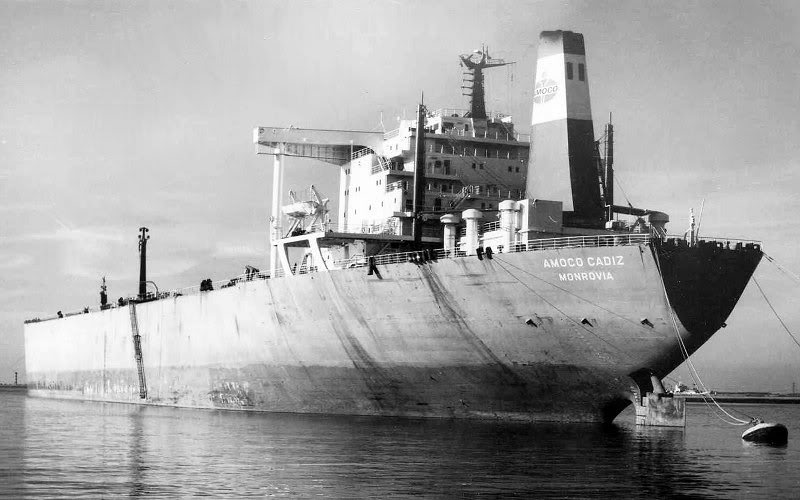
"Amoco Cadiz".
( Photo Copyright Reserved )
"Amoco Cadiz", at the Lisnave Dockyard, Lisbon, Portugal, around 1976.
( Photo Copyright Reserved )
"Amoco Cadiz".
( Photo Copyright Reserved )
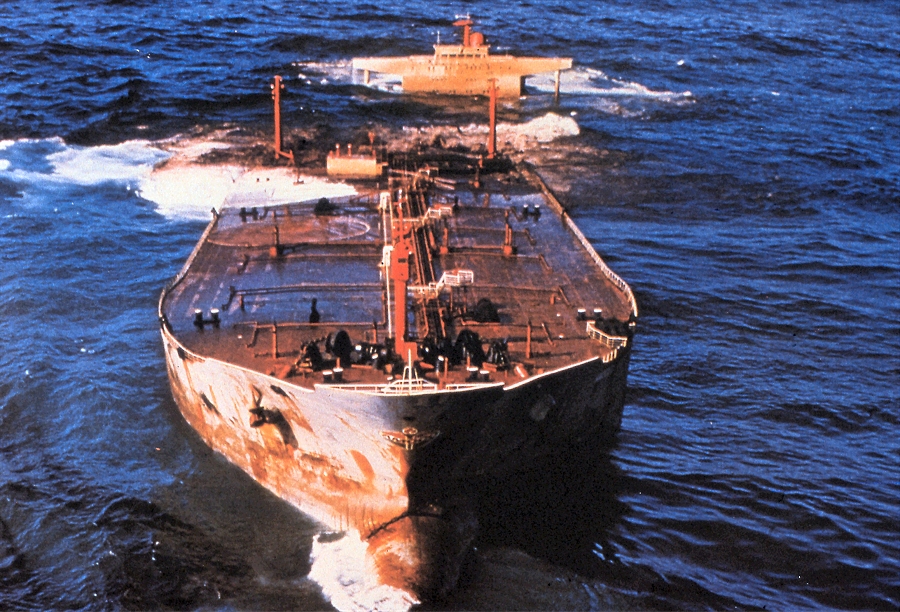
( Photo Copyright David Freeman )
( Photo Copyright Reserved )
The "Amoco Cadiz" was a VLCC (Very Large Crude Carrier), owned by Amoco, that split in two after running aground on
Portsall Rocks, three miles (5 km) off the coast of Brittany (France), on March 16, 1978, resulting at that time in the largest
oil spill ever, currently the fifth-largest in history, though its ranking may vary depending on criteria.
See below for more : Sequence of events
The wreck of the "Amoco Cadiz" is located at 48°36.00' N, 04°46.00' W.
( Photo Copyright Reserved )
"Amoco Cadiz".
( Photo Copyright Reserved )
"Amoco Cadiz".
( Photo Copyright Reserved )
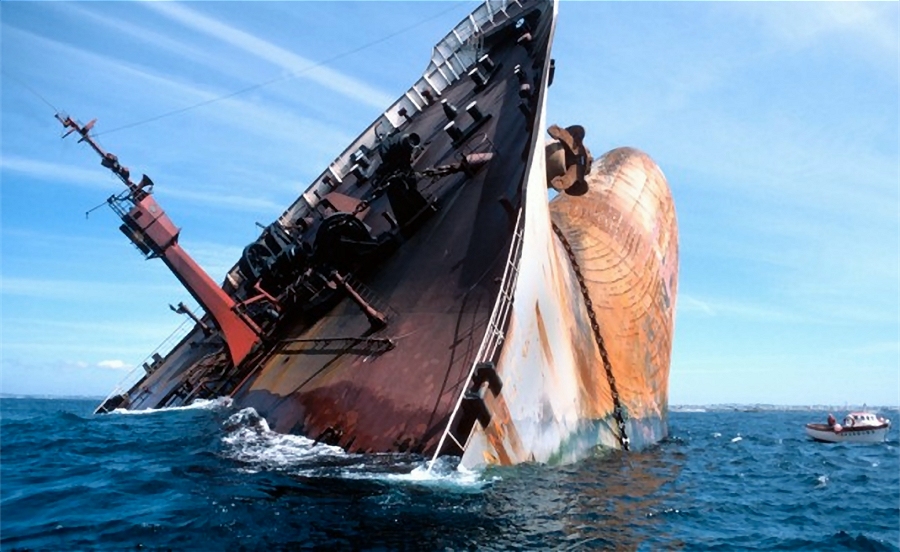
( Photo Copyright Reserved )
The Miramar Ship Index for
|
AMOCO CADIZ
|
IDNo / IMO
|
7336422
|
Year
|
1974
|
Name
|
AMOCO CADIZ
|
Flag
|
LBR
|
Owner
|
Amoco Transport Co.
|
Type
|
Tanker
|
Tons
|
109700
|
DWT
|
233690
|
LOA
|
334,00
|
LPP
|
313,00
|
Beam
|
51,10
|
Dept
|
26,19
|
Draft
|
19,81
|
Machinery
|
1D-15
|
kW
|
22678
|
ShipDesign
|
VLCC
|
Builder
|
Ast Espanoles (AESA)
|
Yard
|
Cadiz
|
Yard No
|
95
|
Country built
|
ESP
|
Keel
|
06.1973
|
Launch
|
24.11.1973
|
Completed
|
13.05.1974
|
Subsequent History
|
Wrecked, sunken and lost.
|
End
|
1978
|
Disposal Data
|
Wrecked 48.36.12 N / 4.45.54 W on 16.03.1978, sunken and lost.
|
En route from the Persian Gulf to Rotterdam, the Netherlands, via a scheduled stop at Lyme Bay, Great Britain, the ship
encountered stormy weather with gale conditions and high seas while in the English Channel. At around 09:45am, a heavy
wave hit the ship's rudder and it was found that she was no longer responding to the helm. This was due to the shearing
of Whitworth thread studs in the Hastie four ram steering gear, built under licence in Spain, causing a loss of hydraulic fluid.
Attempts to repair the damage were made but proved unsuccessful. While the message "no longer manoeuvrable" and
asking other vessels to stand by was transmitted at 10:20am, no call for tug assistance was issued until 11:20am.
The German tug Pacific responded and contacted the Amoco Cadiz at 11:28am, offering assistance under a Lloyds Open
Form (see below). It arrived on the scene at 12:20pm, but because of the stormy sea, a tow line was not in place until 2pm
and broke off at 4:15pm. Several attempts were made to establish another tow line and the Amoco Cadiz dropped its an-
chor trying to halt its drift. Finally a successful tow line was in place at 8:55pm. Yet these measures proved incapable of
preventing the supertanker from drifting towards the coast because of its huge mass and the Force 10 storm winds.
At 9:04pm, the Amoco Cadiz hit the bottom for the first time, flooding its engines. It grounded again at 9:39pm, this time
ripping the hull and starting the oil spill. Its crew was rescued by helicopters of the French Navy at midnight, except the
captain and one officer who remain on board until 5am the next morning.
At 10am, March 17, the supertanker broke in two, releasing its entire cargo of 1.6 million barrels (250,000 m3). Because
of the ongoing storm, it broke again on March 28 and the wreck was later completely destroyed by depth charges from the
French Navy. The wreck of the Amoco Cadiz is located at "48°36.00'N, 04°46.00'W.
Lloyds Open Form
An argument arose between the captain of the Amoco Cadiz, Pasquale Bardari, and that of the captain of the German Tug
Pacific, Hartmut Weinert, on the issue of LOF (Lloyds Open Form). Captain Weinert thought this a classic LOF case, an oil
tanker with damage to its steering gear, rough weather and getting closer to the shore by the minute.
Lloyds Open Form is a standard legal document for a proposed salvage operation, a four page long contract published by the
famous Lloyds of London. It is called "open" because it is literally open, with no amount of money being stipulated for the
salvage job: The sum to be paid is determined later in London by a professional arbitrator. At the top of page one, be-
neath the title "Salvage Agreement" is a statement of the contract's fundamental premise. "NO CURE - NO PAY!"
The Arbitrator, who is invariably a Queen's Counsel practising at the Admiralty Bar, follows the English law of civil salvage, in
determining the salvage award. The values of the ship, its cargo and freight at risk are taken into account when the arbitrator de
cides what the award should be, together with the extent of the dangers and the difficulty in effecting the salvage. In 1978, the ship
and the cargo were valued at about $40 million dollars, so Captain Weinert's company could, in the event of success,
have received a large award. Captain Bardari of the Cadiz, on the instructions of his owners, wanted "...towage rate to Lyme Bay."
The argument dragged on from 11:28am when the Pacific first made contact with the Amoco Cadiz until 4:00pm when Captain
Bardari finally received approval to accept the LOF from the ship's owners in Chicago. However, this dispute did not delay the
salvage operation significantly, because tugging preparations had already started. Captain Weinert was aware that if he were
to succeed in bringing the tanker into Lyme Bay, on the English coast, his owners could arrest the ship in the English High
Court in pursuit of a claim for salvage.
It was incorrectly reported in the Press at the time that, after long negotiations on financial terms between the ship's captain
and the master of a West German tugboat and two unsuccessful towing attempts, the towline finally broke during the argument
and the ship drifted on the rocks. This version of events became fixed in the public mind although in fact delay was caused by
Captain Bardari of the Amoco Cadiz contacting his owners in Chicago for instructions. The delay in sending a distress mes-
sage meant that the larger tug Seefalke, which might have been in range an hour earlier, had proceeded out of range
by the time the distress call was made.
Oil spill
The Amoco Cadiz and coast of Brittany.
The Amoco Cadiz contained 1,604,500 barrels (219,797 tons) of Arabian Light and Iranian Light crude oil.[ Both are medium
weight oils with an API gravity of 34.8. Bunker C is a heavy product with an API of between 7 and 14. But severe weather result-
ed in the complete breakup of the ship before any oil could be pumped out of the wreck. Therefore its entire cargo of crude oil
(cargo which belonged to Shell) spilled into the sea.
A 12-mile (19 km) long slick and heavy pools of oil were smeared onto 45 miles (72 km) of the French shoreline by north-
westerly winds. Prevailing westerly winds during the following month spread the oil approximately 100 miles (160 km) east
along the coast. One week after the accident, oil had reached Côtes d'Armor.
Oil penetrated the sand on several beaches to a depth of 20 inches (510 mm). Sub-surface oil separated into two or three lay-
ers due to the extensive sand transfer that occurred on the beaches during rough weather. Piers and slips in the small harbors
from Porspoder to Brehat Island were covered with oil. Other affected areas included the pink granite rock beaches of Tregastel
and Perros-Guirrec, as well as the tourist beaches at Plougasnou. The total extent of oiling one month after the spill in-
cluded approximately 200 miles (320 km) of coastline. Beaches of 76 different Breton communities were oiled.
Oil persisted for only a few weeks along the exposed rocky shores that experienced moderate to high wave action. In the
areas sheltered from wave action, however, the oil persisted in the form of an asphalt crust for several years.
Environmental impact
Oiled beach in Brittany.
The isolated location of the grounding and rough seas hampered cleanup efforts for the two weeks following the incident.
As mandated in the "Polmar Plan", the French Navy was responsible for all offshore operations while the Civil Safety
Service was responsible for shore cleanup activities. Although the total quantity of collected oil and water reached
100,000 tons, less than 20,000 tons of oil were recovered from this liquid after treatment in refining plants.
The nature of the oil and rough seas contributed to the rapid formation of a "chocolate mousse" emulsification of oil and
water. This viscous emulsification greatly complicated the cleanup efforts. French authorities decided not to use disper-
sants in sensitive areas or the coastal fringe where water depth was less than 50 meters. Had dispersant been applied
from the air in the vicinity of the spill source, the formation of mousse may have been prevented.
At the time, the Amoco Cadiz incident resulted in the largest loss of marine life ever recorded from an oil spill. Mortalities
of most animals occurred over the two month period following the spill. Two weeks following the accident, millions of
dead mollusks, sea urchins, and other bottom dwelling organisms washed ashore.
Diving birds constituted the majority of the nearly 20,000 dead birds that were recovered. The oyster mortality from the spill
was estimated at 9,000 tons. Fishermen in the area caught fish with skin ulcerations and tumors.
Some of the fish caught in the area reportedly had a strong taste of petroleum. Although echinoderm and small crustacean
populations almost completely disappeared, the populations of many species recovered within a year. Cleanup activities on
rocky shores, such as pressure-washing, also caused habitat impacts.
The Amoco Cadiz spill was one of the most studied oil spills in history. Many studies remain in progress. This was the larg-
est recorded spill in history and was the first spill in which estuarine tidal rivers were oiled. No follow-up mitigation existed
to deal with asphalt formation and problems that resulted after the initial aggressive cleanup.
Additional erosion of beaches occurred in several places where no attempt was made to restore the gravel that was re-
moved to lower the beach face. Many of the affected marshes, mudflats, and sandy beaches, were low-energy areas.
Evidence of oiled beach sediments can still be seen in some of these sheltered areas. Layers of sub-surface
oil still remain buried in many of the impacted beaches.
The ship and spill features in one of Steve Forbert's songs about oil pollution.
Legal claims
In 1978, it was estimated to have caused $250 million in damage to fisheries and tourist amenities. The French government
presented claims totalling $2 billion to United States courts.
In subsequent legal proceedings in Chicago, United States, the owners of the tug were held to have been completely blameless
while France was awarded $120 million from the American oil company Amoco in 1990.
|
